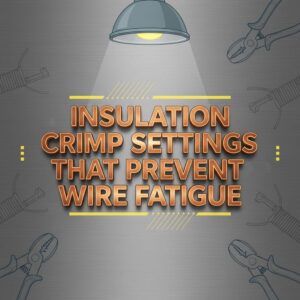Part 2 of a Two-Part Technical Series on Wire Crimp Connector Types and How to Crimp Electrical Terminals
Electrical integrity is built, not assumed.
This second installment in our Hudson Valley technical series takes the theory of crimp connector design and puts it into practice. It covers the full process of forming, verifying, and maintaining a professional-grade crimp—from wire preparation to tool calibration. Whether in a school shop, fleet garage, or industrial panel, the goal is the same: consistent, repeatable joints that conduct power safely under vibration, heat, and time. This is how a technician earns trust not through inspection reports, but through performance that endures.
Behind it sits the insulation support barrel. Its only job is to grab the wire’s outer jacket, spreading strain and vibration away from the crimped conductor. When the wire is pulled, bent, or vibrated, the insulation support absorbs those forces, preventing them from being transmitted to the conductive joint.
It’s important not to confuse function with support. The insulation crimp does not carry current or contribute to the electrical connection’s strength—it simply guards it. Without it, repeated motion would flex the copper strands at the barrel edge until they broke.
Together, the two barrels act like muscle and bone. The wire barrel provides strength and conductivity; the insulation barrel provides stability and protection. When both are properly formed, the result is a joint that resists both electrical failure and mechanical fatigue—exactly what every crimp is designed to achieve.
A proper crimp is built step by step, never rushed. Each motion in the process has a reason, and skipping even one detail weakens both the electrical path and the mechanical bond. Closed-barrel terminals, in particular, demand precision—every millimeter of wire and barrel must align exactly as engineered.
The process begins with preparation and inspection. Strip the insulation cleanly, exposing bright copper without any nicks or missing strands. A square, even cut ensures every strand carries its share of current once crimped. Before proceeding, inspect under good light; even a single broken strand means starting over.
Next, match the tooling to the job. Select the correct die cavity that corresponds exactly to both the terminal and the wire size. The die shape defines the pressure profile, and a mismatch—too loose or too tight—will distort the barrel or damage the wire.
Insert the wire with intent and precision. Push the stripped conductor into the terminal until about one millimeter of copper extends just beyond the front of the barrel. This small projection ensures the strands fully seat at the bottom during compression, eliminating voids that could increase resistance.
Position the terminal in the die with equal care. Leave roughly one millimeter of the barrel uncrimped at the front—this creates the bellmouth, a slight flare that relieves stress on the strands as they exit the crimp. The bellmouth is not cosmetic; it’s proof the die pressure flowed correctly and the strands weren’t pinched or cut.
Crimp with a full, uninterrupted cycle. A ratcheting crimp tool should not release until the correct compression force has been applied. Stopping short results in a weak, incomplete joint. When the ratchet clicks open, inspect your work: the barrel should be uniformly compressed, the insulation captured in its support section, and the wire centered with no visible gaps.
Finish with verification. Many professional tools leave a small dot or code stamped on the barrel—this dot code confirms that the proper die and tool combination was used. Together, the bellmouth and dot mark stand as visible evidence of a crimp done right: tight, clean, repeatable, and ready for service.
Heavy-gauge power cables demand absolute precision. As the wire size increases, so does the current, and even a slight mismatch between terminal, die, and tool can generate enough heat to damage insulation or melt a connector. That’s why every part of the system—the copper tube terminal, the crimping die, and the press itself—must come from the same manufacturer and be tested together as a certified set. Only then can the technician guarantee the compression force and geometry are exactly as designed.
Copper conductors call for the hexagonal crimp. This method compresses the barrel evenly from all sides, forming a smooth, dense joint that captures every strand of wire without cutting or flattening them. The hex shape provides a 360° grip and eliminates air gaps, producing a connection with minimal electrical resistance and high tensile strength. In power distribution and battery systems, this uniform contact area ensures efficient current flow and long-term reliability under heavy load.
Example from the Field – Rural Highway Operations
“Back in the day, I worked with a small highway crew out in the town of Cochecton, New York. They were the kind of people who kept the roads open no matter what — plow trucks running at dawn, graders clearing shoulders, lights still working after the third storm of the week. Their wiring took a beating from salt, moisture, and vibration, and they needed terminations that wouldn’t quit halfway through winter.
I supplied them with heat-shrink sealed crimp terminals — cross-linked polyolefin sleeves with adhesive-lined interiors. Once crimped and heated, the sleeve would contract, the adhesive would flow, and the connection became fully sealed from the weather. It wasn’t about fancy specs — though they met UL, CSA, and MIL standards — it was about keeping the lights on and the gear alive through the worst conditions.
The clear tubing made it easy to check the crimp, and that flexible outer wall spread the strain along the wire jacket instead of snapping at the barrel. They used them everywhere — plow controls, lighting harnesses, under-hood circuits — anywhere the road threw punishment. In that line of work, a good crimp wasn’t optional; it was survival.”
Aluminum conductors require a different approach. Unlike copper, aluminum quickly forms a hard oxide layer that resists electrical contact. The indent crimp solves this by using a pointed die that presses deeply into the barrel at several points, breaking through that oxide film and exposing clean metal beneath. The localized pressure forms direct metal-to-metal contact and locks the strands in place, preventing future oxidation from spreading through the joint.
Every large-wire crimp is a balance of force and geometry. Use the manufacturer’s specified die, apply the full press stroke, and inspect the result for even deformation and complete closure. With heavy cable, there’s no margin for error—resistance, heat, and failure all start where components were not precisely matched. A correctly executed hex or indent crimp, by contrast, becomes a permanent bond capable of carrying current safely for the life of the system.
Every perfect crimp begins with a healthy tool. Even the most skilled technician can’t make a reliable connection if the crimping dies are worn, dirty, or out of calibration. The tool’s geometry defines the pressure, shape, and compression depth of every joint. When those tolerances drift, the crimp loses its designed strength and conductivity—often without any visible sign of failure.
Calibration isn’t optional; it’s part of the craft. Each crimping tool must be checked either annually or after about 10,000 cycles, whichever comes first. Heavy production use may require even shorter intervals. This inspection ensures that the dies still close to the exact dimensions specified by the manufacturer. Over time, the repeated force of crimping can cause minute wear that changes how the jaws meet, slightly enlarging the die opening and reducing compression.
The Go/No-Go gauge is the standard for accuracy. This small precision gauge has two ends: one marked Go and the other No-Go. To test the die, the Go end should pass smoothly through the die opening, while the No-Go end must stop before entering. If both ends pass—or both fail—the tool is out of tolerance and must be recalibrated or replaced. This simple check confirms that every crimp made will fall within the safe and tested pressure range.
Think of calibration as preventive medicine for your tooling. A few minutes spent checking alignment, die wear, and closure pressure saves countless hours troubleshooting bad crimps later. When your tools stay within spec, every crimp they produce can be trusted to perform exactly as engineered—tight, consistent, and electrically sound.
A crimping tool is only as good as the care it receives. Even the best-calibrated die will fail to perform if dirt, grit, or corrosion builds up in the mechanism. A few minutes of attention at the end of each shift preserves accuracy, prevents wear, and ensures that every squeeze of the handle delivers the same precise pressure as the day the tool was new.
Cleanliness comes first. Wipe the jaws and frame daily to remove dust, metal shavings, and moisture. Salt air, humidity, and even fingerprints can leave residues that corrode the steel surfaces over time. A soft brush and a clean cloth are usually enough; never use abrasives that could alter the die geometry or surface finish.
Lubrication keeps the motion smooth. Apply a light film of general-purpose machine oil to all pivot points and moving joints. This prevents friction and wear in the linkage system that controls die closure. Too much oil can attract debris, so use sparingly—a single drop in each joint is enough.
Always check the ratchet before starting work. The ratchet mechanism is what ensures a full crimp cycle—it should hold firmly until the correct compression is reached, then release cleanly. If it slips, sticks, or releases early, the tool can no longer guarantee consistent pressure and must be serviced immediately.
Daily maintenance is small work that protects big results. A well-kept tool stays accurate, feels smooth in the hand, and maintains the rhythm of precision crimping day after day. It’s the simplest habit that separates careless assembly from professional electrical craftsmanship.
Setting the insulation crimp is about balance, not brute force. The insulation crimp—or strain relief—is the terminal’s second grip, designed to hold the wire’s jacket firmly enough to prevent motion, but not so tight that it crushes or cuts through the insulation. This setting is adjustable on most professional crimping tools, and dialing it in correctly is the key to making joints that survive years of vibration and flexing.

The setup procedure is simple but precise. Start by inserting an unstripped section of wire into the terminal and closing the insulation crimp. This test uses the jacket itself as the gauge for proper tension. Once the crimp is complete, hold the terminal securely and bend the wire up 90°, then down 90°. This simulates the mechanical stress a wire endures in real service—pulls, bends, and vibration.
Observe the result carefully. The wire should stay firmly gripped, with no sliding or looseness. The insulation must remain intact—no pinching, tearing, or flattened areas. If the wire slips out of the terminal during the bend test, the crimp setting is too loose. Tighten the adjustment by one notch and repeat the process until the wire holds firmly without damage.
The goal is firm restraint with zero injury. The insulation support’s purpose is purely mechanical—it transfers strain away from the conductor. A correct setting gives the wire freedom to flex just beyond the terminal without stressing the copper underneath. Once that balance is achieved, the insulation crimp becomes the quiet guardian of every joint, protecting it from the daily movement that would otherwise cause fatigue and failure.
Precision is the quiet language of reliability.
Every perfect crimp is the sum of discipline—clean tools, correct dies, measured pressure, and verified results. Each strand of copper, each terminal, each cycle of the ratchet represents a technician’s care and intent. In the Hudson Valley and beyond, the work isn’t just about joining wire to metal—it’s about connecting reliability to every circuit that keeps our machines alive. When every crimp holds true, so does the system it serves.


